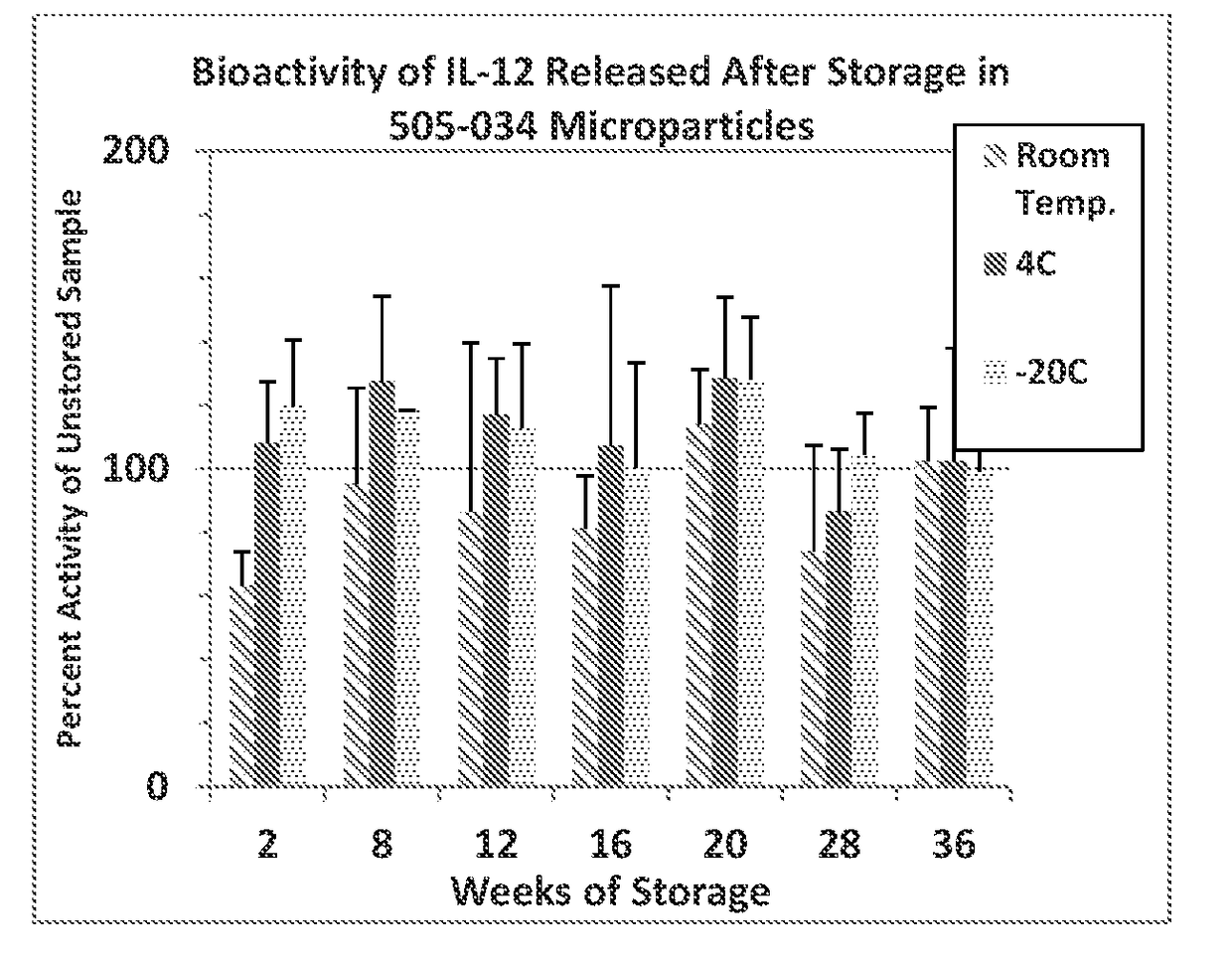Compositions for stabilizing and delivering proteins
a technology of proteins and compositions, applied in the direction of drug compositions, peptide/protein ingredients, antibody medical ingredients, etc., can solve the problems of significant obstacles in the development of effective drug delivery systems, and achieve the effect of improving storage stability
- Summary
- Abstract
- Description
- Claims
- Application Information
AI Technical Summary
Benefits of technology
Problems solved by technology
Method used
Image
Examples
example 1
on of Encapsulated TGF-β1
[0143]Step 1
[0144]25 mg each of Tween® 20, Tween® 80, PEG 4500 and Pluronic F127 were added to 1 ml of doubly distilled water (solution A). 50 mg each of sucrose, glycine and PVP K15 were added to 1 ml doubly distilled water (solution B). Each solution was filtered with a sterile filter using 0.2 μm syringe into new cryotube vials. 7.2 μl of solution A and 71.7 μl of solution B were added by pipet to a lyophilization vial containing 5.0 ml of 99% tert-butyl alcohol. 500 μl of 1.00 mg / ml stock solution of mTGF-β1 (Peprotech) was added, followed by lyophilization. The mixture was lyophilized at −40° C. for 120 min.
[0145]Step 2
[0146]250 mg of low MW PLA ˜9 KDa and 250 mg of medium MW PLA ˜36 KDa polymer were dissolved in 6 ml dichloromethane. 2.25 g of PEG 3350 and 0.75 g of Pluronic F127 were added to the PLA solution and dissolved with ten seconds of vortex. 1.67 ml 97% EtOH was added to the solution containing PLA, PEG3350 and F127 and mixed thoroughly. Appr...
example 2
on of Blank Particles
[0150]The process described in Example 1 was used to prepare blank matrices by substituting 500 μl of doubly distilled water for the mTGF-β1 solution. The matrices were precipitated from a solution of 500 ml heptane and 0.05 ml Span 80.
example 3
on Studies of Polymer Matrix
[0151]In order to determine the stability of various polymer excipient blends, films were casts using the polymers described below. The polymers were dissolved in dichloromethane and the clear solutions were cast into a glass petri dish. The dichloromethane was allowed to evaporate under ambient conditions to provide the film.
TABLE 1CompositionRatio (w-w)#11 g PLLA, 5 g PEG 335016.7%-83.3%#21 g PLGA, 5 g PEG 335016.7%-83.3%#31 g FASA, 5 g PEG 335016.7%-83.3%#41 g PS, 5 g PEG 335016.7%-83.3%#50.5 g PLLA, 2.75 g PEG 335015.4%-84.6%#60.25 g PLLA, 1.125 g PEG 3350, 0.375 g14.3%-64.3%-21.4%F127#70.5 g PLLA, 0.1 g PEG 335083.3%-16.7%#85 g PEG 3350 0%-100%Key:PLLA = Poly-l-lactic acid (50% / 50% low / high MW)PLGA = Polylactic co-glycolic acid (RG 503 H)FASA = Polyfumaric-co-sebacic anhydride (20:80)PS = Polystyrene
[0152]Samples weighing approximately 37.7 mg were scraped from each of the above films. Accurate masses were obtained from each sample, and each sample w...
PUM
| Property | Measurement | Unit |
|---|---|---|
| Temperature | aaaaa | aaaaa |
| Fraction | aaaaa | aaaaa |
| Time | aaaaa | aaaaa |
Abstract
Description
Claims
Application Information
 Login to View More
Login to View More - R&D
- Intellectual Property
- Life Sciences
- Materials
- Tech Scout
- Unparalleled Data Quality
- Higher Quality Content
- 60% Fewer Hallucinations
Browse by: Latest US Patents, China's latest patents, Technical Efficacy Thesaurus, Application Domain, Technology Topic, Popular Technical Reports.
© 2025 PatSnap. All rights reserved.Legal|Privacy policy|Modern Slavery Act Transparency Statement|Sitemap|About US| Contact US: help@patsnap.com



